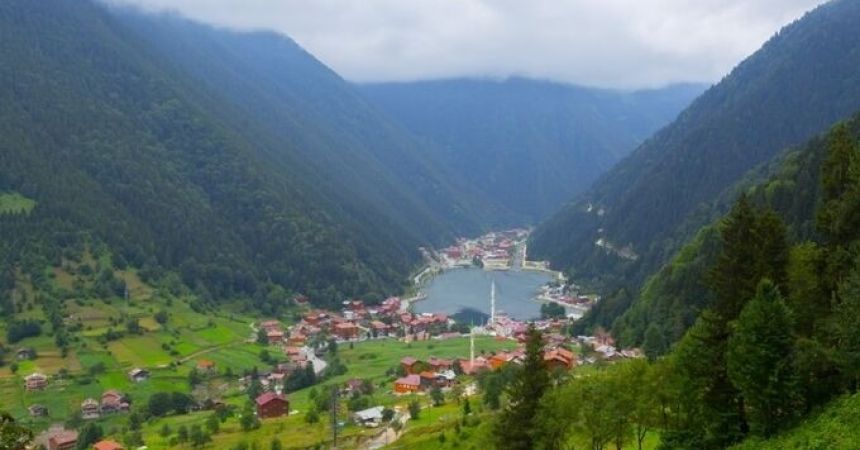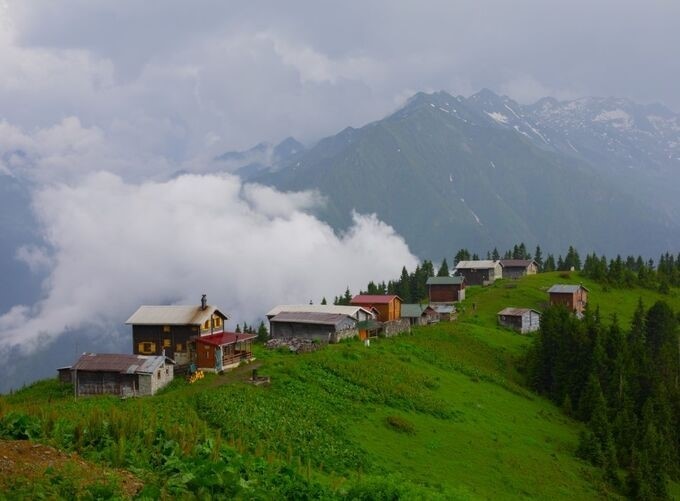
Explore Sumela Monastery | Trabzon’s Iconic Landmark
Nestled in the lush mountains of northeastern Turkey, the Sumela Monastery is a remarkable testament to the region's rich cultural and religious history. Perched dramatically on the face of a steep cliff, this ancient monastery has been a beacon of spirituality and architectural ingenuity for centuries. In this blog, we will delve into the history, significance, and breathtaking beauty of Sumela Monastery, offering insights into why it is a must-visit destination for travelers exploring Turkey.
Historical Background of Sumela Monastery
Origins and Founding
The Sumela Monastery, also known as the Monastery of the Virgin Mary, is believed to have been founded in 386 AD during the reign of the Roman Emperor Theodosius I. According to legend, the monastery was established by two Athenian monks, Barnabas and Sophronius, who discovered a miraculous icon of the Virgin Mary in a cave on the mountain. This icon, believed to have been painted by Saint Luke, became the focal point of the monastery's spiritual significance.
Byzantine Era
Throughout the Byzantine era, Sumela Monastery flourished as a center of religious scholarship and pilgrimage. It gained considerable support from several Byzantine emperors, who contributed to its expansion and enrichment. The monastery's remote and rugged location provided a haven for monks seeking solitude and spiritual contemplation.
Ottoman Period
The Ottoman conquest of the region in the 15th century marked a new chapter in the history of Sumela Monastery. Despite the change in political power, the monastery continued to thrive, benefiting from the Ottomans' relatively tolerant approach to religious institutions. During this period, the monastery saw significant renovations and expansions, including the addition of impressive frescoes and architectural features.
Modern Era and Restoration
Sumela Monastery continued to be an important religious site until the early 20th century. Following the population exchanges between Greece and Turkey in 1923, the monastery was abandoned and fell into disrepair. However, in recent decades, extensive restoration efforts have been undertaken to preserve and revive this historical gem, making it accessible to visitors from around the world.
Architectural Marvels of Sumela Monastery
Dramatic Location
One of the most striking aspects of Sumela Monastery is its dramatic location. The monastery is built into the sheer face of a cliff, 1,200 meters above sea level, in the Altindere National Park in the Trabzon Province. This precarious position gives the monastery an awe-inspiring presence and offers stunning views of the surrounding forested mountains and valleys.
Main Complex
The main complex of Sumela Monastery consists of several interconnected buildings, including chapels, monks' quarters, a library, and a kitchen. The buildings are arranged on multiple levels, connected by a series of narrow stairways and walkways that cling to the cliffside.
The Rock Church
At the heart of the monastery is the Rock Church, a cave church that houses the iconic frescoes depicting scenes from the Bible and the lives of saints. These frescoes, dating back to the 18th century, are renowned for their vivid colors and intricate details, showcasing the artistic talent of the period.
The Holy Spring
Another notable feature of the monastery is the Holy Spring, located within the complex. The spring is believed to have miraculous healing properties, and it has been a site of pilgrimage for centuries. Pilgrims and visitors often collect water from the spring, seeking its blessings.
The Cultural and Spiritual Significance of Sumela Monastery
Religious Importance
Sumela Monastery has long been a significant site of religious pilgrimage, particularly for Orthodox Christians. The monastery's dedication to the Virgin Mary and the presence of the miraculous icon have made it a focal point for spiritual devotion and veneration.
Cultural Heritage
Beyond its religious significance, Sumela Monastery is a symbol of the rich cultural heritage of the Pontic Greeks who inhabited the region for centuries. The monastery's art, architecture, and traditions reflect the historical and cultural interactions between the Greek and Byzantine worlds.
Festivals and Celebrations
One of the most important events associated with Sumela Monastery is the annual celebration of the Feast of the Assumption of the Virgin Mary on August 15th. This event attracts thousands of pilgrims and visitors, who come to participate in religious services, processions, and festivities that honor the Virgin Mary.
Exploring Sumela Monastery: A Visitor's Guide
How to Get There
Sumela Monastery is located in the Altindere National Park, approximately 48 kilometers south of the city of Trabzon. The most convenient way to reach the monastery is by car or bus from Trabzon. The journey takes about an hour and offers scenic views of the Black Sea coast and the lush countryside.
Entrance and Hours
The monastery is open to visitors throughout the year, although hours may vary depending on the season. It's advisable to check the latest information on opening hours and entrance fees before planning your visit to Trabzon. The entrance to the monastery is a short hike from the parking area, involving a scenic trail through the forest.

What to See in Sumela
- The Main Courtyard: Upon entering the monastery, visitors are greeted by the main courtyard, which offers panoramic views of the surrounding landscape and access to the various buildings of the complex.
- The Rock Church and Frescoes: The highlight of any visit is the Rock Church, where the stunning frescoes can be admired up close. These artworks depict a range of religious scenes and are a testament to the monastery's rich artistic heritage.
- The Monastic Cells and Chapels: Explore the monastic cells and chapels scattered throughout the complex. These spaces provide insight into the daily lives of the monks who once resided here.
- The Holy Spring: Don't miss the opportunity to visit the Holy Spring and perhaps collect some of its water, which is believed to have healing properties.
Tips for Visitors
- Wear Comfortable Shoes: The trail to the monastery and the complex itself involve a fair amount of walking and climbing stairs. Comfortable shoes are essential.
- Bring Water and Snacks: While there are facilities at the site, it's a good idea to bring your own water and snacks, especially if you plan to spend an extended time exploring.
- Respect the Site: As a place of historical and religious significance, visitors are encouraged to respect the site by adhering to guidelines, refraining from touching the frescoes, and maintaining a respectful demeanor.
The Natural Beauty Surrounding Sumela Monastery
Altindere National Park
Sumela Monastery is situated within Altindere National Park, a protected area known for its stunning natural beauty. The park is home to dense forests, cascading waterfalls, and diverse wildlife, making it a paradise for nature lovers and outdoor enthusiasts.
Hiking and Nature Trails
The park offers numerous hiking and nature trails that allow visitors to explore the pristine landscapes surrounding the monastery. These trails vary in difficulty, providing options for both casual walkers and experienced hikers. Along the way, you'll encounter breathtaking viewpoints, serene streams, and the rich flora and fauna of the region.
Wildlife and Flora
Altindere National Park is home to a variety of wildlife, including bears, deer, and numerous bird species. The lush vegetation includes a mix of deciduous and evergreen trees, with vibrant wildflowers adding splashes of color throughout the year. For those interested in botany and wildlife photography, the park offers ample opportunities to capture the natural beauty of the region.
Sumela Monastery: A Symbol of Resilience and Preservation
Historical Challenges
Throughout its history, Sumela Monastery has faced numerous challenges, including natural disasters, invasions, and periods of neglect. Despite these adversities, the monastery has endured, thanks to the dedication of those who have worked to preserve its legacy.
Restoration Efforts
In recent years, extensive restoration efforts have been undertaken to safeguard the monastery for future generations. These efforts have included structural repairs, conservation of the frescoes, and improvements to visitor facilities. The restoration work aims to balance the need for preservation with the desire to make the site accessible and enjoyable for visitors.
Cultural Revival
The reopening of Sumela Monastery to visitors and the continuation of religious services have played a crucial role in the cultural revival of the site. Events such as the Feast of the Assumption of the Virgin Mary attract pilgrims and tourists alike, fostering a renewed appreciation for the monastery's spiritual and cultural significance.
Experiencing the Magic of Sumela Monastery
You can visit Sumela Monastery with a Guided tour of Turkey is more than just a historical site; it is a place where natural beauty, spiritual devotion, and architectural brilliance converge. Whether you are drawn by its rich history, stunning art, or serene surroundings, a visit to Sumela Monastery promises to be a memorable and enriching experience.
As you explore the cliffside wonder of Sumela, you will not only witness the legacy of the Hittite Empire but also gain a deeper understanding of the cultural and religious heritage that has shaped this remarkable site. From the intricate frescoes of the Rock Church to the breathtaking views of Altindere National Park, Sumela Monastery offers a journey through time and nature that will leave you inspired and awestruck.



